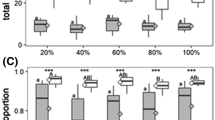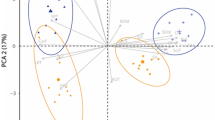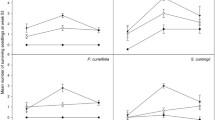Abstract
To test whether the impact of drought on the growth and biomass allocation of first-season shade-tolerant woody seedlings in low irradiance differs from that in high irradiance, seedlings of Viburnum lantana, V. opulus, V. tinus and Hedera helix were grown in pots at two watering frequencies × three irradiances. Hypotheses in the recent literature variously predict that drought will have a stronger, weaker or equal impact on seedling relative growth rate (RGR) in deep shade relative to that in moderate shade. Experimental irradiance levels were selected in the typical range for temperate deciduous forest seedlings in either understorey or clearings: 3–4% daylight (low red: far-red shade), 3–4% daylight (neutral shade), and 30–40% daylight (neutral shade). Watering was 'frequent' (every 3–4 days) or 'infrequent' (five times during the 8-week experiment), producing soil matric potentials as low as –0.03 MPa, and –2 MPa. To prevent the interaction of irradiance and watering treatments, each seedling was grown in a 'shade tower' that was surrounded by an uncovered sward of grass (Festuca rubra), which depleted pot water at the same rate regardless of the species of seedling, or its irradiance treatment. Shading affected all species: seedlings in 3.5% daylight grew at 56–73% of their dry-mass RGR in 35% daylight. Low red: far-red shade reduced the RGR of Hedera to 68% of its value in neutral shade. Infrequent watering significantly reduced the RGR of only V. lantana and V. opulus, by approximately the same proportion across irradiance treatments. Infrequent watering did not significantly alter any species' biomass allocation across irradiance treatments. Such orthogonal impacts of deep shade and drought on seedling growth and biomass allocation indicate a large potential for niche differentiation at combinations of irradiance and water supply for species of forest seedlings, and suggest a multiplicative-effects approach for modelling seedling performance in microsites with different combinations of irradiance and water supply.
Similar content being viewed by others
Author information
Authors and Affiliations
Corresponding author
Additional information
Electronic Publication
Rights and permissions
About this article
Cite this article
Sack, L., Grubb, P.J. The combined impacts of deep shade and drought on the growth and biomass allocation of shade-tolerant woody seedlings. Oecologia 131, 175–185 (2002). https://doi.org/10.1007/s00442-002-0873-0
Received:
Accepted:
Published:
Issue Date:
DOI: https://doi.org/10.1007/s00442-002-0873-0




